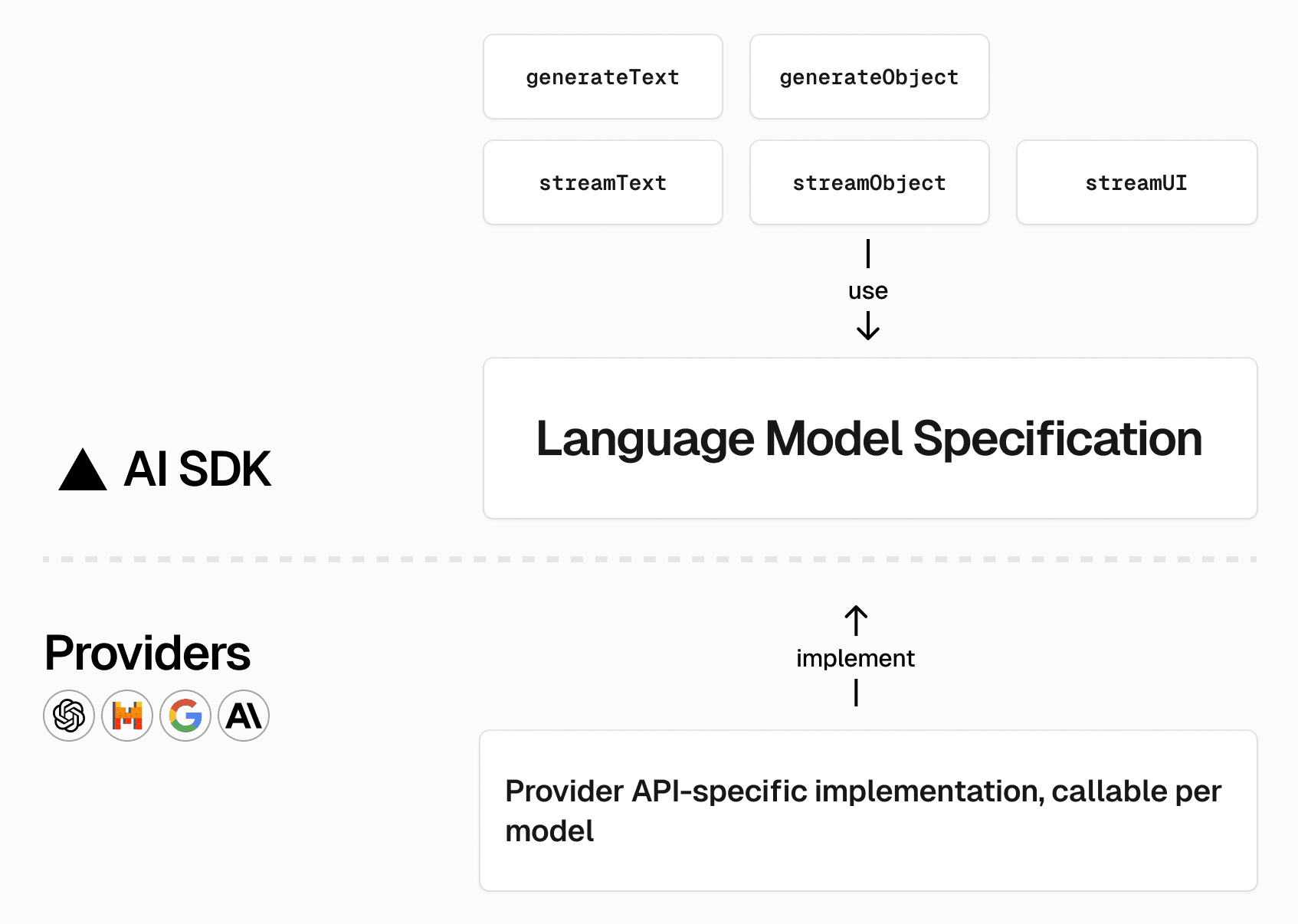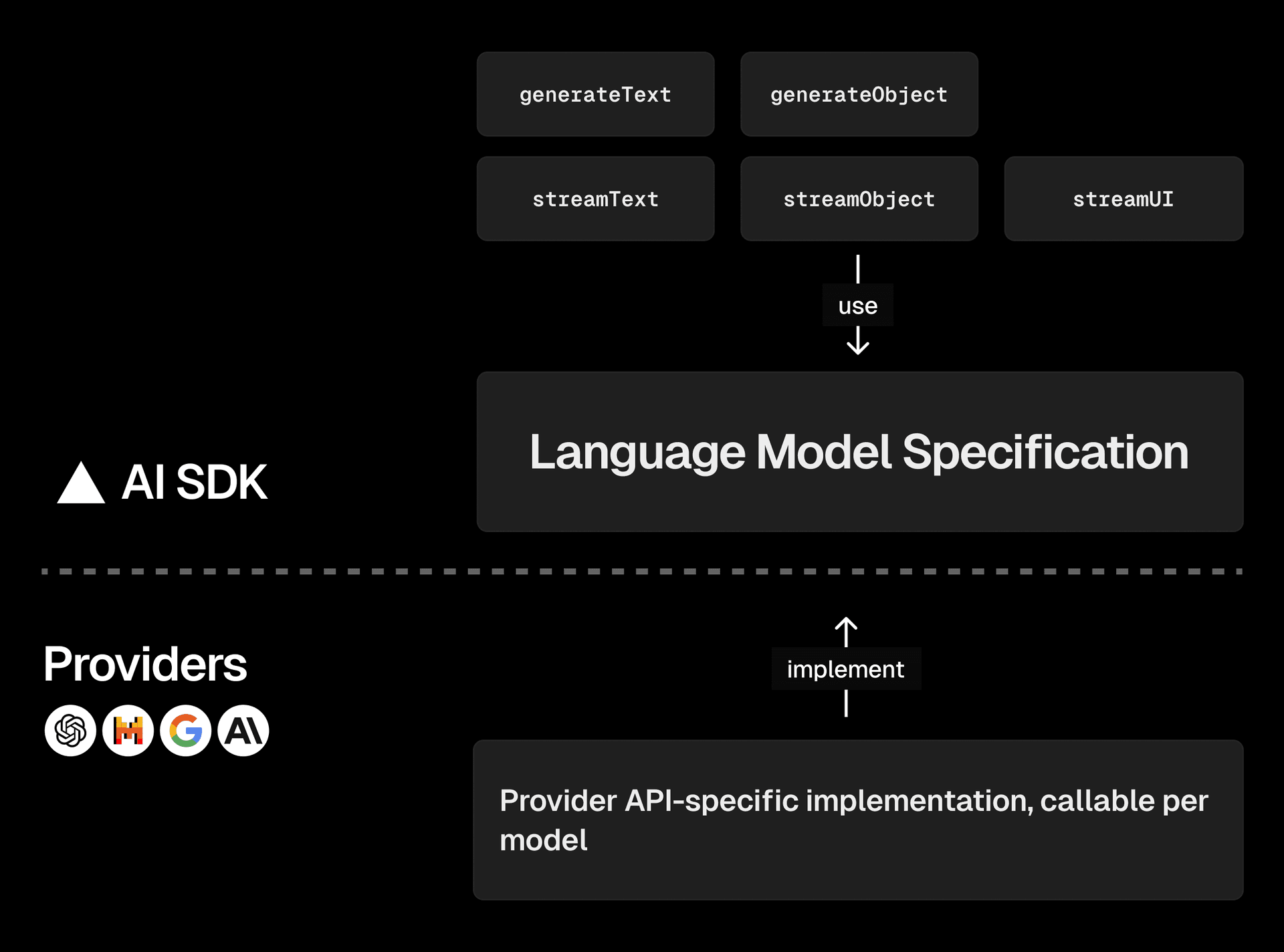3 min read
One step closer to a complete TypeScript framework for AI applications
Today, we're releasing the AI SDK 3.1, with ModelFusion joining our team.
This release brings us one step closer to delivering a complete TypeScript framework for building AI applications. It is organized into three main parts:
AI SDK Core: A unified API for generating text, structured objects, and tool calls with large language models (LLMs).
AI SDK UI: A set of framework-agnostic hooks for quickly building chat interfaces.
AI SDK RSC: A library to stream generative user interfaces with React Server Components (RSC).
AI SDK Core - A new foundation for AI
Drawing inspiration from projects like Drizzle and Prisma, you can imagine the AI SDK Core as an ORM-style abstraction for LLMs.
These new APIs provide a set of unified, low-level primitives to work with LLMs in any JavaScript environment—abstracting away the quirks between major model providers. This simplifies integrating LLMs down to just two decisions:
What kind of data do you want to generate? (text or a structured object)
How do you want it delivered? (incrementally streamed or all-at-once)


You can use the AI SDK Core API with any provider that implements the AI SDK Language Model Specification. We worked with major AI model providers to iterate on the Vercel AI SDK Core, and already support:
OpenAI
Anthropic
Google Gemini
Mistral
The Language Model Specification is open-source. Anyone can now build AI provider integrations that work seamlessly with the Vercel AI SDK, and our amazing community has already started to add support for providers such as LLamaCpp.
Generating text
Here’s an example of generating text with AI SDK Core using the mistral-large-latest model from Mistral AI.
import { generateText } from 'ai';import { mistral } from '@ai-sdk/mistral';
const { text } = await generateText({ model: mistral("mistral-large-latest"), prompt: "Generate a lasangna recipe.",});If you want to switch out the model for OpenAI’s gpt-4-turbo, you can do so by changing two lines of code.
import { generateText } from 'ai';import { openai } from '@ai-sdk/openai';
const { text } = await generateText({ model: openai("gpt-4-turbo"), prompt: "Generate a lasagna recipe.",});Generating Structured Data
The Vercel AI SDK standardizes structured object generation across model providers with the generateObject and streamObject functions. Generating fully typed objects is as simple as defining a Zod schema and passing it to your function call.
import { generateObject } from 'ai'import { z } from 'zod'import { openai } from '@ai-sdk/openai';
const { object } = await generateObject({ model: openai('gpt-4-turbo'), schema: z.object({ recipe: z.object({ name: z.string().describe('name of recipe'), ingredients: z.array( z.object({ name: z.string().describe('ingredient name'), amount: z.string().describe('amount of ingredient') }) ), steps: z.array(z.string()).describe('steps to prepare recipe') }) }), prompt: 'Generate a lasagna recipe.'})The model returns a validated and type-safe object — in this case, a lasagna recipe — based on your predetermined schema.
{ "name": "Classic Lasagna", "ingredients": [ { "name": "Olive oil", "amount": "2 tablespoons" }, ... ], "steps": [ "Preheat oven to 375°F (190°C).", "In a large skillet, heat olive oil over medium heat. Add ground beef, onion, and garlic. Cook until beef is browned.", ... ]}
AI SDK UI - Chat interface in seconds
Streaming conversational text UIs (like ChatGPT) have gained massive popularity over the past year. However, a basic chat interface still requires complex boilerplate: state management (tracking client input, conversation history, loading state), logic to parse and process streaming text, lifecycle hooks to manage persistent data, and more.
AI SDK UI simplifies the implementation of popular AI interfaces into three framework-agnostic hooks, useChat, useCompletion, and useAssistant. Together with AI SDK Core’s streamText function, you can build a streaming chatbot in less than 50 lines of code.
import { streamText } from 'ai';import { openai } from '@ai-sdk/openai';
export async function POST(req: Request) { const { messages } = await req.json();
const result = await streamText({ model: openai('gpt-4-turbo'), messages, });
return result.toAIStreamResponse();}'use client'
import { useChat } from 'ai/react'
export default function Page() { const { messages, input, handleInputChange, handleSubmit } = useChat();
return ( <> {messages.map(message => ( <div key={message.id}> {message.role === 'user' ? 'User: ' : 'AI: '} {message.content} </div> ))} <form onSubmit={handleSubmit}> <input name="prompt" value={input} onChange={handleInputChange} id="input" /> <button type="submit">Submit</button> </form> </> )}In this Next.js App Router example, the useChat hook enables streaming chat messages from OpenAI, manages the chat state, and updates the UI automatically as new messages arrive.
AI SDK RSC - Move beyond text
While AI chatbots have made a profound impact, LLM applications have faced two important UX challenges:
Limited or imprecise knowledge
Plain text or markdown-only responses
With the introduction of Tools and Tool Calling, developers can build more robust applications that fetch realtime data.
With Vercel AI SDK RSC, you can now move beyond text-based chatbots to give LLMs rich, component-based interfaces.
In today's release, we're adding streamUI, a new function that's compatible with AI SDK Core Language Model Specification. This is the successor to render (which we plan to deprecate in the next minor release).
Let’s look at an example React Server Action that can retrieve the live weather and render a custom UI with streamUI.
import { streamUI } from 'ai/rsc'import { openai } from '@ai-sdk/openai'import { z } from 'zod'import { Spinner, Weather } from '@/components'import { getWeather } from '@/utils'
async function submitMessage(userInput) { // 'What is the weather in SF?' 'use server'
const result = streamUI({ model: openai('gpt-4-turbo'), messages: [ { role: 'system', content: 'You are a helpful assistant' }, { role: 'user', content: userInput } ], text: ({ content }) => <p>{content}</p>, tools: { get_city_weather: { description: 'Get the current weather for a city', parameters: z.object({ city: z.string().describe('the city') }).required(), generate: async function* ({ city }) { yield <Spinner/> const weather = await getWeather(city) return <Weather info={weather} /> } } } })
return result.value}Towards a complete TypeScript AI framework
The Vercel AI SDK 3.1 marks an important step towards delivering a complete TypeScript AI Framework.
With the AI SDK Core, you get a unified API for calling LLMs that works anywhere JavaScript or TypeScript runs.
With the AI SDK UI, you can build chat interfaces in seconds with framework-agnostic hooks.
Finally, with the AI SDK RSC, you can go beyond chat interfaces to deliver the next generation of AI native applications with Generative UI.
You can learn more in our new documentation or experiment with different models using the AI playground.
Explore the possibilities
Talk to our team to learn more about building AI-powered applications for your organization.
Get started